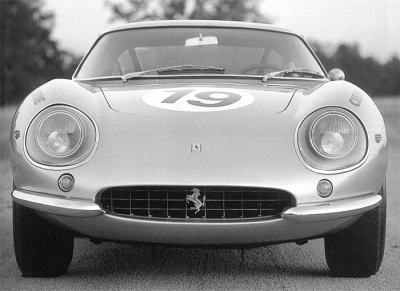
The aggressive 275 GTB is today more coveted by collectors than the Lusso, even though the Lusso's design has endured the test of time-generally agreed as among the most pure and beautiful products to come out of the collaboration between Ferrari and Pininfarina. The 275 GTB has other distinctive attributes, not least its place as the first fully independent suspension Ferrari road car and the power and tractability of its 3.3-liter 600 V12 engine developed from the one-liter Colombo "short block" originally designed in 1947.
Series production of road Ferraris continued with the 275 GTB, first with two-cam engines and later with four-cam versions, as the mainstay of the marque. Ferrari knew this highly evolved Berlinetta with its improved rear suspension and the balance permitted by its rear-mounted transaxle would, like all good Ferraris, be driven from showroom floor to race-track paddock.
Ferrari created a 275 GTB that more closely adapted to the requirements of racing, the 275 GTB/C (for "Competizione"). They are one of the least known, but most important and successful Ferrari sub-types.
In 1966, Ferrari responded to heightened sports car and endurance racing competition with the 2nd series 275 GTB/C. It was a production car in name only, for under its skimpy one-mm thick alloy skin there was the heart of a true race car, built by the Ferrari racing department and designed by Mauro Forghieri.
The first example (chassis 9007 shown here) 2nd series 275 GTB/Cs were for serious competitors. The 2nd series 275 GTB/Cs weigh more than 300 pounds less than the standard production alloy-bodied 275 GTBs. With their high output competizione engines, their performance is exceptional.
Of the twelve 2nd series 275 GTB/Cs built, 9007 is the first of the line and is commonly regarded as one of the finest of the twelve GTB/Cs. Completed on May 3, 1966, it was sold new to Sergio Tullio Marchesi who, in the best Ferrari tradition, raced it in the Targa Florio only five days later, winning the GT category driving with Sinibaldi. Two months later Marchesi/Lessona finished 8th overall and 2nd in class at Mugello.
In 1968, 9007 was sold to J.S. Hanrioud in France who continued to campaign the car in national events, including the Tour de France. In 1992, Hanrioud and Marin again entered 9007 in the Tour de France, before selling it in 1993 to the United States where it has remained since in two significant Ferrari collections.
Even more than the fabled 250 GTO, the 275 GTB/C is the pinnacle of production-based front V12-engined competition cars. With less than a third of the GTO's thirty-nine-unit production, the 275 GTB/C is much more rare. It also is lighter, more powerful and better balanced due to its rear-mounted transaxle and independent rear suspension.
SCM Analysis
The car described here sold for $1,212,500 at the Christie’s Pebble Beach auction held on August 29, 1999. The competition versions of the 275 GTB came in three distinct series. The most desirable are the first series cars with their not exactly stock appearing lightweight body and chassis, six-carb dry sump engine, alloy bumpers, etc. As a total package they can be considered a Series Three GTO. There are three of those cars extant and their value is in the $2-4M range.
The second variant is the “Cliente Competitzione” model, a wet sump six-carb car with an oversize nintey-four-liter fuel tank, alloy bodywork with rear fender vents, outside filler, etc. Eleven of these cars were built. These cars, often called “alloy six carbs,” are considered to be worth in the $750-800K range.
This car, 9007 is the third variant, the 275 GTB/C. They values fall between those of the other two version. The GTB/C are very late cars and all have 9000 series chassis numbers. They carry a lightweight body/chassis and dry sump, three-carb engine with magnesium valve covers, alloy bumpers, magnesium transaxle case, etc. Not as powerful, light, or as rare as the first iteration, they are still very effective weapons at Ferrari competition events. With 280 horsepower and a curb weight of about 2500 lb, the GTB/C is faster than a GTO, rarer than a GTO and a fraction of the price of a GTO. This example exceeded the SCM range by a good margin but, for good reason: It has the best history of any GTB/C and is in tidy, restored condition.
